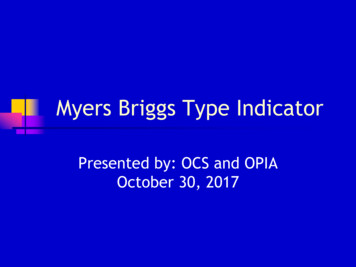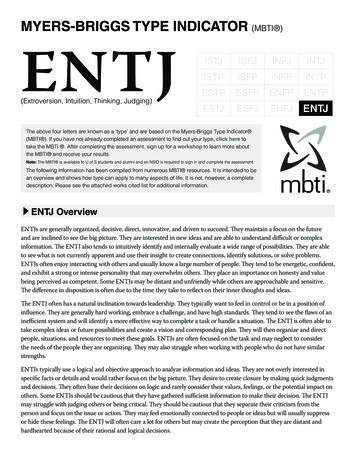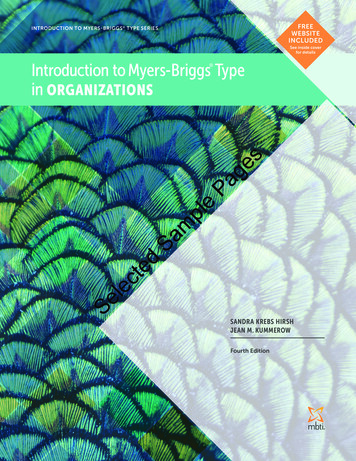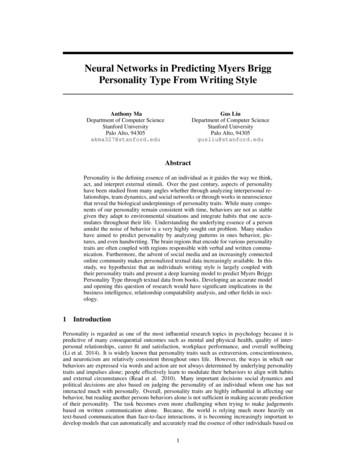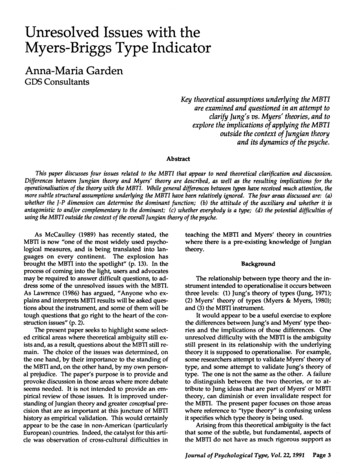
Transcription
Unresolved Issues with theMyers-Briggs Type IndicatorAnna-Maria GardenGDS ConsultantsKey theoretical assumptions underlying the MBTIare examined and questioned in an attempt toclarify Jung's vs. Myers' theories, and toexplore the implications of applying the MBTIoutside the context of Jungian theoryand its dynamics of the psyche.AbstractThis paper discusses four issues related to the MBTI that appear to need theoretical clarification and discussion.Differences between Jungian theory and Myers' theory are described, as well as the resulting implications for theoperationalisation of the theory with the MBTI. While general differences between types have received much attention, themore subtle structural assumptions underlying the MBTI have been relatively ignored. The four areas discussed are: (a)whether the J-p dimension can determine the dominant function; (b) the attitude of the auxiliary and whether it isantagonistic to and/or complementary to the dominant; (c) whether everybody is a type; (d) the potential difficulties ofusing the MBTI outside the context of the overall Jungian theory of the psyche.As McCaulley (1989) has recently stated, theMBTI is now "one of the most widely used psychological measures, and is being translated into languages on every continent. The explosion hasbrought the MBTI into the spotlight" (p. 13). In theprocess of coming into the light, users and advocatesmay be required to answer difficult questions, to address some of the unresolved issues with the MBTI.As Lawrence (1986) has argued, "Anyone who explains and interprets MBTI results will be asked questions about the instrument, and some of them will betough questions that go right to the heart of the construction issues" (p. 2).The present paper seeks to highlight some selected critical areas where theoretical ambiguity still exists and, as a result, questions about the MBTI still remain. The choice of the issues was determined, onthe one hand, by their importance to the standing ofthe MBTI and, on the other hand, by my own personal prejudice. The paper's purpose is to provide andprovoke discussion in those areas where more debateseems needed. It is not intended to provide an empirical review of those issues. It is improved understanding of Jungian theory and greater conceptual precision that are as important at this juncture of MBTIhistory as empirical validation. This would certainlyappear to be the case in non-American (particularlyEuropean) countries. Indeed, the catalyst for this article was observation of cross-cultural difficulties inteaching the MBTI and Myers' theory in countrieswhere there is a pre-existing knowledge of Jungiantheory.BackgroundThe relationship between type theory and the instrument intended to operationalise it occurs betweenthree levels: (1) Jung's theory of types (Jung, 1971);(2) Myers' theory of types (Myers & Myers, 1980);and (3) the MBTI instrument.It would appear to be a useful exercise to explorethe differences betweenJung's and Myers' type theories and the implications of those differences. Oneunresolved difficulty with the MBTI is the ambiguitystill present in its relationship with the underlyingtheory it is supposed to operationalise. For example,some researchers attempt to validate Myers' theory oftype, and some attempt to validate Jung's theory oftype. The one is not the same as the other. A failureto distinguish between the two theories, or to attribute to Jung ideas that are part of Myers' or MBTItheory, can diminish or even invalidate respect forthe MBTI. The present paper focuses on those areaswhere reference to "type theory" is confusing unlessit specifies which type theory is being used.Arising from this theoretical ambiguity is the factthat some of the subtle, but fundamental, aspects ofthe MBTI do not have as much rigorous support asJournal of Psychological Type, Vol. 22,1991Page 3
the more general (and more easily measured) reliability and validity aspects. While the Manual (Myers &McCaulley, 1985) cites many studies which validatethe general properties of the theory, such as occupational classifications of the preferences, and criterionbased correlations of the preferenc(:s, almost all ofthese studies are validating the existence of the broadcategories only, and their effect on our choices, behaviour, or attitudes. In effect such studies (as wellas the classic studies of Carlyn, 1977; Richek, 1969;Stricker & Ross, 1963, 1964a) may validate no morethan a trait interpretation of the scales. Such studies donot validate the critical structural assumptions of thetypological theory. Finding a significant positive relationship between the S-N scale and IQ tests 'provides support for the notion that differences on thewhole S-N scale (or increasing N) means "something." However, such a result does not address suchMBTI assumptions as that Sand N are truly dichotomous types, or that the scale measures degree of preference, not degree of development.More important is the question whether thesedeeper assumptions are, in any event, part of Jungiantheory, or based on Myers' theory. It is precisely thestructure of type theory that needs addressing, notanother study showing which types populate a typetable in a particular occupation. Indeed, a number ofthe basic building blocks of Myers' theory have barely been examined, and where they have, the evidencehas not always been supportive (Carlson, 1985).Researchers whose reviews of the MBTI havebeen somewhat critical (e.g., McCrae & Costa, 1989;Stricker & Ross, 1964b), are often attempting to validate the structural properties of Jung'5 theory. This explains the apparently contradictory nature of such(negative) assessments of the MBTI relative to thewealth of supporting data in the Manual. One of thereasons for this difference in assessments might bethe lack of conceptual clarity referred to above. Ifhaziness exists between the theories of Jung andMyers, then it would not be surprising for the deeperand more refined assumptions not to have been satisfactorily examined empirically. For this reason, thispaper concentrates on clarifying the theoretical basisof the MBTI and not on the validation or empiricalwork already performed or needing to be performed.Related to this, both the empirical and practicaluse of the MBTI have become not only independentof the Jungian theory of psychological types, but alsoseparate from the Jungian theory of the psyche as a whole.Taking only part of Jungian theory produces a verydifferent range of ideas than taking the whole theory.Recent MBTI applications, particularly to organisations, appear to take the MBTI theory further and further away from the Jungian theory. Increasingly,these applications have become more focused andmore prescriptive. In doing so, much of what is mostPage 4Journal of Psychological Type, Vol. 22, 1991critical and unique in the Jungian approach to understanding the dynamics of personality has been lost.The last section of the present paper attempts to illustrate the difficulties that will result if this approach istranslated into action.The arguments in this paper set out the author'sinterpretations of Jung's and Myers' theories. Theseinterpretations cannot be definitive, any more thanMyers' interpretation of Jung can be. Such potentialdiversity merely argues for an open debate.(a) Does the J-p dimension determine theextraverted function and, hence, the dominantfunction?The Judging-Perceiving dimension is an important addition to type theory. One of the difficult tasksconfronting Myers was to provide a way to determine which function was dominant and which wasauxiliary. Her method for doing this was the creationof the J-p dimension, designed to measure whichfunction is used outwardly, since, in her view, thiswould determine indirectly which function is thedominant and which is the auxiliary. The J-p dimension is usually explained as making explicit a conceptthat was implicit in Jungian theory. Jung certainlydescribed people in terms of being "judging" or "perceiving" types, this designation referring to someonewith a judging function dominant (thinking or feeling), or a perceiving function dominant (intuition orsensing). This is stated very clearly; e.g., "1 call thetwo preceding types (extraverted thinking and extraverted feeling) rational or judging types becausethey are characterised by the supremacy of the reasoning and judging functions" (Jung, 1971, p. 359).To Jung, the introverted judging types (or introvertedrational types) refer to the introverted thinking andintroverted feeling types--i.e., where thinking andfeeling are dominant (Jung, 1971).Note that this is a very different formulation thanthe terms "judging" or "perceiving" as used inMyers' theory. In the latter, being a J or a P refers notto having a judging function or a perceiving functiondominant, but to having a judging function or a per ceiving function extraverted. In Myers' theory (Myers& McCaulley, 1985), for introverts a judging type hasa dominant perceiving function.To some degree the above difference is purelyone of terminology, and being consistent within onetheoretical framework or another is what is critical.However, the J-p addition to the theory is not justmaking a Jungian idea "explicit"; it is much morethan that.Some authors have argued that the very notion ofa separate J-p dimension is actually contrary toJungian theory. In his review of the MBTI, Coan(1978) described the addition of the J-p index as an
"interesting innovation" that "appears to constitute adeparture from Jungian theory, since the Jungian typology does not presuppose a tendency of people tofavor judgment over perception or vice versa. Anemphasis on either mode of judgment is balanced byde-emphasis of the opposite mode, and the sameprinciple applies to the two perceptual modes" (p.974). In other words, at a theoretical level one mayhave a dominant judging function, but one does notthereby have a judging orientation over a perceivingone, since the inferior function is similarly judgingand negates the effect of the judging nature of thedominant.In addition, the notion that each person has an"extraverted function," which for extraverts is thedominant and for introverts is the auxiliary, is a rationale derived from Myers' formulation of type theory. In other words, the assumption that introvertsuse an extraverted auxiliary for the outer world, anassumption that directly underpins the use of the J-pdimension as a pointer to the dominant function, isMyers' own. Whether or not it is also Jung's is certainlya matter for debate.There are, then, a number of sources of theoretical difference between Jung and Myers with respectto the notion of being judging or perceiving. Whenconsidering the operationalisation with the MBTI, weneed to be clear that it is Myers' theory and notJung's theory that forms the primary and direct basis.In any event, there are concerns about whether ornot the MBTI has satisfactorily operationalisedMyers'theory. The basis of assuming that J-p measures which function is extraverted derives from thewording of the items in the questionnaire. This is explained in McCaulley (1981) as follows: "If one couldknow whether the extraverted function is a perception or a judgment function, then one could also identify the (extraverted) dominant for the extravertedtypes and the (extraverted) auxiliary for the introverted types" (p. 302). Behavioural characteristics associated with extraverting of a perceiving function or ajudging function had been noted. As a result, a"fourth index, the judgment perception (J-P) indexwas developed to tap these behavioural indicators .the J-p index is designed to elicit attitudes and beh,aviours that are extraverted" (pp. 302-303). As amethod of resolving the difficulty in determiningdominant or auxiliary, this solution is ingenious.There are two problems with it, however.The most serious problem is that we don't knowif it actually works. Coan (1978) describes the rationale in the Manual as "an intriguing bit of psychometric reason, but it has not been satisfactOrily validated. The JP preference has been found in researchapplications to discriminate in useful ways, but itsvalue in assessing Jungian types remains doubtful"(p. 630). In other words, it is an assumption that the J-P scale determines which type of function is used inthe outer world, an assumption which has not yetbeen satisfactorily validated. We do not yet knowwhether or not the J-p scale does point to the extraverted function and, hence, indirectly to the dominant function. Remarkably few studies have attempted to validate the assumption that the J-p dimensioncan be used to determine the dominant function.Those which have, such as Carlyn (1980) and McCraeand Costa (1989), did not find support for the MBTImethod as a means of assessing the Jungian function.Both these studies used preference scores or standardized preference scores as an alternative indicatorof dominance on the grounds that the dominant is, bydefinition, the most preferred, a theoretical a&sertionmade by Myers and McCaulley (1985); i.e., that lithedominant function will show a clearer preferencethan will the auxiliary" (p. 58). No doubt there existarguments against such a research design or theirparticular way of assessing dominance, yet the factremains that even if one were to reject their findings,one would still be left needing support for Myers' hypothesis. In summary, the Myers method of determining the dominant function, using the J-p dimension, may not be the best method; most assuredly it isnot the only method, and should for the present betreated as a working hypothesis, not as an establishedfact.The second problem with Myers' solution ofusing a J-p index to determine the dominant and auxiliary functions is with its logic rather than with itsvariation. As indicated above, the J-p dimension wasderived after noting the behavioural characteristicsassociated with extraverting a perceiving function ora judging function. To the extent that this logic restson the assumption that our behaviour is determinedonly by the conscious (dominant or auxiliary) function, we need to be careful. For example, as Jung(1971) cautions with respect to extraverted judgingtypes, outward behaviour is determined as much byour unconscious functions. The question this posesfor the MBTI is whether the J-p index, even if it doesassess extraverted functioning, can isolate that extraverted behaviour that derives from a consciousfunction but not from an unconscious function.However, there are some a priori reasons whythe J-p index may not indicate the extraverted function in spite of the intention that it do so. Assessingthe rationale behind the J-p index is difficult, sincethe precise logical justification for exactly how it performs its assigned role is unclear. Is a respondentsupposed to be in an extraverted mode when responding to J-p items (but not 5-N and T-F items)?Are the items supposed to directly gauge extravertedbehaviour, or are they supposed to intrinsically express an outer-world context? The assumption in thispaper is that the J-p index performs its assigned roleJournal of Psychological Type, Vol. 22,1991Page 5
through the content of the items themselves suggesting an outer-world reference, and thus the questionnaire response reflects the nature of the function usedto deal with the outer world. If this assumption iscorrect, the question arises whether the J-p items doevoke an outer-world reference but the 5-N items andT-F items are substantively different and do not alsodo so. A cursory reading of the items does not revealthat the 5-N and T-F items are any different from theJ-p items in that regard.Looking at the J-p items alone, it is conceivablethat the phrase items evoke an outer-world referenceor that their content has an outer-world reference, butwhat about the context-free word pairs? How can aword-pair evoke the context of dealing with the outerworld? Even a word-pair that one might presume tobe relevant only in an outer-world sense (e.g., scheduled vs. unplanned), may not refer to one's extraverted function. For example, it may be possible for one'sintroverted function to be concerned with the "scheduled" option and for the scheduling to occur in one'sinner world; yet one might deal with the outer worldin an unplanned way. If the word-pair evokes the introverted orientation or has an inner-world reference(for whatever reason), then such a J-p option cannot,in that instance, be measuring what it is supposed tobe measuring--Le., one's extraverted function.Ultimately, answers to such questions need to be empirically based.(b) Is the auxiliary of an introvert, extraverted,and that of an extravert, introverted?Further, is the auxiliary complementary to,or antagonistic to, the dominant?At the theoretical level, the differences betweenMyers' theory and Jungian theory have been acknowledged; specifically, that Jungians tend to assertthat the auxiliary is of the same attitude as the dominant. In the discussions of Gray and Wheelwright(1946) and Whitmont (1969), the auxiliary is seen ashaving the same attitude as the dominant function.However, as Quenk (1984, p. 7) states, "few references to the auxiliary function" can be found in theJungian typology literature. The argument has beenmade by Myers that it is implicit in Jung's writingsthat the auxiliary is of a different attitude than thedominant (Myers, 1980). The specific quotation sheasserts this from is as follows: "The rule holds goodthat, besides the conscious, primary function, there isa relatively unconscious auxiliary function which isin every respect different from the nature of the primary function" (Jung, 1971, pp. 405-406). Myers argues from this, in particular from the phrase "is inevery respect different," that Jung is saying that theattitude of the auxiliary complements the attitude ofthe dominant and, therefore, is in the opposite attiPage 6Journal of Psychological Type, Vol. 22, 1991tude (Myers & McCaulley, 1985). Quenk logically deduces a similar view. However, to Jungians it is clearthat the body of Jung's writing does not suggest suchan interpretation.One explanation for the different interpretationswith respect to the attitude of the auxiliary is thatJung tended to assume that only the dominant wouldclearly be in the conscious sphere, and that the otherthree functions would be more, if not completely, unconscious. Jung (1971) describes "the effects regularly produced on the other functions when preferenceis given to one function. They remain in a more orless primitive and infantile state, often only half conscious or even quite unconscious" (p. 540). If the person were characterised as introverted and, hence, theintroverted attitude as conscious, then all the functions in the unconscious would be extraverted. Onecould then infer, even though Jung did not state it explicitly, that whatever is in the conscious spherewould take on an introverted attitude. It is also arguable that for Jung only the dominant is truly in theconscious sphere; in general one would not expect theauxiliary to be so, or to be treated as such. This is different from the assumptions implicit in the form inwhich the MBTI profile is presented-i.e., that the twopreferred functions (the dominant and the auxiliary)are both in the conscious sphere.The second critical difference with Jung is theMyers notion that the conscious sphere need not bewholly introverted and, hence, every such function introverted (or extraverted, as the case may be). Myers,in contrast, is arguing that one could have both an introverted function and an extraverted function "developed" [i.e., in the conscious sphere (Myers &McCaulley, 1985; Myers, 1980)].Thus, this may not be so much an argumentabout the attitude of the dominant versus the auxiliary, but one concerning first the attitude of consciousness versus that of unconsciousness, and secondly, whether the auxiliary is considered consciousor unconscious. Given Jung's (1971) premise that theauxiliary is primarily unconscious, its attitude wouldof necessity be "in every respect different" from theattitude of the dominant. By definition, it must be extraverted. However, this is because the auxiliary is inthe unconscious, not because the attitude of the auxiliary needs to "balance" that of the dominant. The latter idea is not part of Jung's argument, but part ofMyers'.An additional component of the theory concerning the auxiliary, which may be more problematic, isthe assumption that the auxiliary is complementaryto, and supportive of, the dominant. This also seemsimplicit in von Franz and Hillman (1979). Yet, a function that is, by definition, perceiving, might be antagonistic to a function that is, by definition, judging inorientation. (A similar argument applies to the no-
tion that an introverted function might be antagonistic to an extraverted one.) These two opposite stancesof a perceiving and judging orientation are assumed,in Myers' theory, to provide balance and to complement each other but only when expressed as a dominant and auxiliary function. Myers and Myers (1980)state that the "two skilled processes can develop sideby side because they are not antagonistic" (p. 183, italics added). Yet, when describing the J-p dimension initself, Myers and Myers describe the fundamental opposition between the two attitudes. However, for thedominant and auxiliary this notion of opposition (between a perceiving function and a judging function)is not discussed. On the contrary, it is stated that"one is always a perceptive process and the other ajudging process so they do not contradict each other"(p. 183). Even within Myers' theory, this seems inconsistent. Further, since in all Jung's theory opposites may be either complementary or antagonistic, this isan assumption which is logically inconsistent withinthe framework of Jung's overall theory of the psyche.(While this may partly be due to the distinction between the J-p dimension reflecting attitudes, and thejudging and perceiving functions representing mentalprocesses, one might still expect potential conflict between different processes even if not the clash of opposites.)In discussing Jung's notion of opposites, Jarrett(1979) points out that feeling and thinking are "opposite to the other opposing pair, sensation and intuition" (p. 323), since they are rational as opposed toirrational. The terms rational and irrational were notsimply abstract classification terms, but impartedmeaning that conveyed their opposition (Jung, 1971).''The irrational functions, sensation and intuition .are those whose aim is pure perception; for, as far aspossible, they are forced to dispense with the rational(which presupposes the exclusion of everything thatis outside reason) in order to attain the most completeperception of the general flux of events" (p.459, italics in the original). Similarly, intuition and sensation"by their very nature, . will react to every possibleoccurrence and be attuned to the absolutely contingent, and must therefore lack all rational direction.For this reason I call them irrational functions, as opposed to thinking and feeling, which find fulfillmentonly when they are in complete harmony with lawsof reason" (p. 455). Given this profound difference inthe nature of the rational functions and the irrationalfunctions, one would theoretically deduce that anauxiliary might well act in a way which is not merelycomplementary to, but hostile to, the intent of thedominant.Thus, at a theoretical level the question of the attitude of the auxiliary as well as whether it can be antagonistic or "opposed to" the dominant, is open fordebate.To my knowledge, the structural property ofMyers' theory with respect to the attitude of the auxiliary has not been validated. Indeed, this tenet ofMyers' theory is not operationalised as such, but is anartifact of the resultant profile. One's interpretation ofthe profile derives from the theory, even if this has nodirect expression in the measure. Given the immensedifficulties in operationalising such a notion, thestatement above need not be seen as a criticism. It isa fact, however.Similarly, the theoretical assumption that theauxiliary provides balance to the dominant ratherthan challenges it in an antagonistic fashion, is another area needing empirical support.(c)Is everybody a type?One of Jung's basic premises was that not everyone should be considered or treated as a type. Hewas particularly explicit about this when talking ofextraversion and introversion. For example, he stated that "It gradually became clear to me that theremust be two fundamentally different general attitudes which would divide human beings into twogroups-provided the whole of humanity consisted ofhighly differentiated individuals. Since this is obviouslynot the case, one can only say that this difference ofattitude becomes plainly observable only when weare confronted with a comparatively well-differentiated personality; in other words, it becomes of practical importance only after a certain degree of differentiation has been reached" (Jung, 1971, p. 549, italicsadded). He suggested that not everyone was extraverted or introverted."There is . a third group, and here it is hard tosay whether the motivation comes chiefly from within or without. This group is the most numerous andincludes the less differentiated normal man, who isconsidered normal either because he allows himselfno excesses or because he has no need of them. Thenormal man is, by definition, influenced as muchfrom within as from without. He constitutes the extensive middle group, on one side of which are thosewhose motivations are determined mainly by the external object, and, on the other, those whose motivations are determined from within. I call the firstgroup extraverted, and the second group introverted"(Jung, 1971, p. 516, italics in the original).This statement could be interpreted as meaningsimply that the attitude of this "third group" is difficult to detect, rather than non-existent. Yet, it is veryclear in his descriptions of the attitude-types andfunction-types, that one should only be treated as atype when one's use of that attitude or function ishabitual. Otherwise, one is not a type; e.g., "when orientation by the object predominates in such a waythat decisions and actions are determined not by subJournal of Psychological Type, Vol. 22, 1991Page 7
jective views but by objective conditions, we speak ofan extraverted attitude. When this is habitual, wespeak of an extraverted type" (Jung, 1971, p. 333, italicsadded). Similarly, he stated that "Introversion andextraversion are not traits of character at all, butmechanisms which can, as it were, be switched on oroff at will. Only from their habitual predominancedo the corresponding characters develop" (Jung,1971, pp. 285-286). In Jung's later writing, his explicitdefinition of type is as follows: 'When any of thesefour basic psychological functions is habitual, thus setting a definite stamp on the character of the individual, I speak of a psychological type" (Jung, 1971, p.482, italics in the original).While Jung posited the attitudes and functions asbeing dichotomous at anyone point in time, this isdifferent from an argument for the existence of dichotomous types. For example, while sensing and intuition are opposites as functions (which can betermed dichotomous) and, at anyone point in timeone must use one or the other by definition, this is notthe same thing as saying that people are either sensing types or intuitive types. (Note, however, that thenotion that the opposites must always exclude eachother is not always accepted by Jungians. See, for example, Jarrett, 1979.) It is the distinction betweenpreferred use of a function per se and being a typethat is critical in Jungian theory.Further, it is only habitual use of a function thatequates with being a "type," while in MBTI theory, itis a preference, however slight, which equates withbeing one type rather than another. In contrastingJung's and Myers' views, McCrae and Costa (1989, p.20) state that "Jung himself appears to adopt this[trait] position in some of his writings, admitting thatthere are intermediate positions between pure introversion and pure extraversion, in which individualsare 'influenced as much from within as from without'(1971, p. 516). The authors of the MBTI, however,have adopted the interpretation that types are mutually exclusive groups of people, and that the cuttingpoint between them is not arbitrary, but a true zeropoint."In summary, it is arguable that every person either is, or should be treated as if he or she were, onetype or another. Instead, there would appear to bemiddle ground. Jung's theoretical position appearedto be that this "middle ground" consisted of twogroups: one where the two functions (or attitudes)were not clearly differentiated at all, and the otherwhere the two functions were both equally developed (d. Saunders, 1988).Validation of this tenet of Myers' theory, i.e., thateveryone is a type, has been limited, and the evidenceequivocal. As Coan (1978, p. 630) states, "the empirical support for the true dichotomy" is tenuous. Thereis a considerable difference between: (a) providingPage 8Journal of Psychological Type, Vol. 22, 1991support for the notion that types exist, and (b) providing support for the notion that everyone is onetype or another. The latter is mutually exhaustive;the former is not. Thus, studies indicating the existence of personality types do not validate the notionof dichotomous types (e.g., Bradway, 1964; Gorlow,Simpson, & Krauss, 1966; Stephenson, 1939).Alternatively, as Myers reported in the 1962 and1985 Manuals (Myers, 1962; Myers & McCaulley,1985), examination might require regressions of onevariable onto the continuous scales of the MBTI to seeif a discontinuous pattern occurred at the midpoint.Earlier consideration of this struc
Myers-Briggs Type Indicator Anna-Maria Garden GDS Consultants Key theoretical assumptions underlying the MBTI are examined and questioned in an attempt to clarify Jung's vs. Myers' theories, and to explore the implications of applying the MBTI outside the context o




